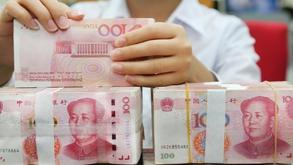 In this undated photo, a clerk counts renminbi yuan banknotes in Nantong, East China's Jiangsu province. (PHOTO / IC)
In this undated photo, a clerk counts renminbi yuan banknotes in Nantong, East China's Jiangsu province. (PHOTO / IC)
BEIJING - China's one-year loan prime rate (LPR), a market-based benchmark lending rate, came in at 3.7 percent Monday, unchanged from the previous month.
The over-five-year LPR, on which many lenders base their mortgage rates, also remained unchanged from the previous reading of 4.45 percent, according to the National Interbank Funding Center (NIFC).
The over-five-year loan primary rate, on which many lenders base their mortgage rates, also remained unchanged from the previous reading of 4.45 percent, according to the National Interbank Funding Center
In May, the over-five-year loan prime rate was cut by 15 basis points to 4.45 percent, the largest reduction in this rate since the country revamped the LPR mechanism in 2019.
Such a move would help the real economy tide over difficulties by leveraging the role of the financial sector, boosting effective demand and further stabilizing the economy, analysts said.
ALSO READ: PBOC, SAFE release battery of measures to boost growth
Closely related to the LPR, the interest rate of the medium-term lending facility (MLF) this month also remained unchanged from the last operation. Last week, the People's Bank of China injected 200 billion yuan ($29.8 billion) into the market through a one-year MLF with an interest rate of 2.85 percent.
Based on bank quotes calculated by adding a few basis points to the interest rate of open market operations (mainly referring to the MLF rate), the LPR is calculated by the NIFC to serve as a pricing reference for bank lending. The LPR currently consists of rates with two maturities -- one year and over five years.
The quoting banks submit their figures before 9 am on the 20th day of every month. The NIFC calculates and releases the LPR at 9:15 am on the same day or on the next working day.
READ MORE: China adopts law on futures, derivatives



